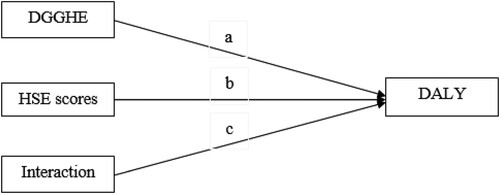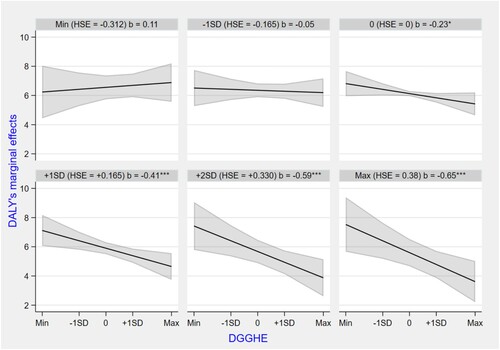Figures & data
Figure 1. Association between DGGHE and the DALY in SSA countries, 2018.
Note. The figure depicts the association between DGGHE and the DALY in 2018 in SSA countries. World development indicators and Global Burden of Disease databases. Copyrights by World Bank and Institute for Health Metrics Evaluation.

Table 1. Karakaplan estimator estimates for the SF model.
Table 2. Summary of efficiency scores for 2008–2018.
Table 3. Description of variables.
Figure 2. Graphical representation of the moderation hypothesis.
Note. The arrows pointing to the DALY represent the path coefficients that measure the impacts of DGGHE, health system efficiency, and the interaction term on the DALY. The interaction term variable is generated as the product of DGGHE and health system efficiency scores. The moderation hypothesis (H2) would be supported if the interaction term were significant. For simplicity, the graph does not present the control variable impacts. Adapted from ‘The moderator–mediator variable distinction in social psychological research: Conceptual, strategic, and statistical considerations,’ by Baron and Kenny, 1986, Journal of personality and social psychology, 51(6), p. 1173. Copyright 1986 by the American Psychological Association, Inc.

Table 4. Descriptive statistics.
Table 5. Correlation between main model variables.
Table 6. Ahn and Schmidt estimator results.
Table 7. Estimates of model and moment selection criteria.
Table 8. Ahn and Schmidt estimator results for the moderation model (Dep. Var. DALY, log).
Table 9. Estimates of model and moment selection criteria.
Table 10. DGGHE marginal effects.
Table 11. Moderator marginal effects.
Figure A1. Moderator marginal effects with 95% CIs. Note. HSE denotes health system efficiency. From the top left to the bottom right, the marginal effects of DGGHE on the DALY are presented when the HSE varies from minimum SD, −1SD, 0SD, + 1SD, + 2SD, to maximum SD, respectively, with 95% confidence intervals. Computed using STATA version 17 software. *p < 0.10; ***p < 0.01.

Data availability
The data that support the findings of this study are available upon request from the corresponding author Josue Mbonigaba, [email protected] +27768706031.
